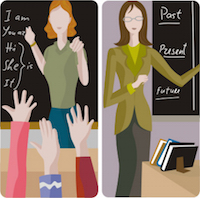Co-Teaching: Toxics, Separatists and Troopers

It’s a new calendar year and we’re halfway through this school year. It’s the perfect spot to stop and notice the learning culture that has been created in our classrooms.
I have to admit, this post is a real co-teaching heart to heart as I reflect on my 15 years of co-teaching experiences and 25 years in education. I believe this post just may stir up some commotion as we all take this time to think about our co-teaching stance.
What we can learn from Stravinsky
If I were to put this blog post to music it would be The Rite of Spring, an orchestral concert work and ballet by the Russian composer Igor Stravinsky. Stravinsky introduced the world to a new way of experiencing ballet. He came along at a time when people were accustomed to the lyrical and delicate works of Tchaikovsky who was easy to listen to. Tchaikovsky had become the vision and expectation of what ballet should be.
Then along came Stravinsky—with this unexpected boldness and intensity—way beyond what people were conditioned to expect. His work shocked the audience at the premiere in Paris to the point of creating a riot in the aisles!
We’re not about to cause any co-teaching riots, but the emotions of experiencing new ideas—and new ways of doing things—always stir up some commotion. In time, folks accepted Stravinsky as another way of enjoying ballet. I think you can see where I’m going.
Now is the time to make some commotion
Now is the time to be honest with yourself and with your co-teacher because we’ve had time to establish relationships and routines—and it’s not too late to make any necessary changes.
If all is moving along smoothly—let each other know. Share time over a cup of coffee to express specifically what is going well and how you may sustain your co-teaching groove the remainder of the year. And congratulations.
If you’re not on a focused and effective path—that’s OK—there’s still time. Take a deep breath, buckle up, and make a change! This mid-point in the year is the perfect moment to tweak (and overhaul, if necessary) any ineffective co-teaching realities.
Either way, co-teachers, this post is for you! It’s time to refresh, rejuvenate, and make sure we make this year the best opportunity for students (and ourselves).
To help us think through this, I’ve put together varying types of potential co-teaching situations. What feels most familiar to you?
Potential Co-Teacher Relationships
- The Toxics:
Teachers who groan, gripe, and complain any chance they get. They run to the principal with slight annoyances that they expand out into crazy proportions.One complains about the other while the other may try to make it work—but spends most of his or her energy knocking the walls down that the other builds on a daily basis. Some may complain about the students—feeling frustrated because “they are just not getting it.” You know these teachers. They do not get along well. In fact, the students in class may easily notice it as one ignores the other—or slings direct rude comments out for all to hear during class time. (Fortunately—I believe this toxic group is a rare occurrence—but, hey…it happens and it cannot be ignored—this group must be redirected!)
- The Separatists:
Teachers who are struggling to make it work. They avoid one another as much as possible. They do what they can during class time, but the only hope of any degree of success is each teacher’s individual efforts. They engage with students in ways that separate themselves from each other. The special education teacher often picks up the pieces during extra help sessions. The adult conversation in these classrooms most often begins with “I” not “We.” In fact one teacher (most times it’s the special education teacher) feels like an uninvited guest. It’s awkward. It’s a chore. And some days can feel like plain torture. The two teachers get along just well enough to make the status quo happen in their rooms each day. But life is one huge agitating roller coaster ride. These teachers must do all they can to lift up and out of status quo—it’s not too late to learn about one another and apply the expertise of both, yes both!, teachers. - The Troopers:
These co-teachers make it work. They just do. It’s not about making it work because they’ve worked together for years—or because they actually like each other and socialize outside of school.Troopers make it work because they understand the value and the privilege of being in a co-teaching role. They find a way to communicate, share, and debrief—no matter what. Their focus is on the learning goals, building relationships and doing all they can to empower the learners in their room. Life is one huge exciting, invigorating, and stimulating roller coaster ride. And these teachers go with the flow—while respecting the perspective and expertise of each other. Those lucky students!
Regardless of which group you fall into—you need to make or reaffirm a commitment to collaborate. Anything is possible when teachers agree to just collaborate. OK, so I believe this quick exercise will work for ANY co-teaching pairing. Seriously—it’s all up to you.
So relax and let’s do this!
Three steps to making a commitment to collaborate
- Perspective Role Play—Yes, that means put yourself in the shoes of your co-teacher. Would you want to work with you? What are you doing to make your co-teacher feel valued and welcomed? Be honest. Are you kind? Thoughtful? Open to other ways of doing things? Do you see the positive attributes that your co-teacher brings to the classroom? Do you create the space for your co-teacher to be an active participant in the learning process? Now…create a t-chart. On the left side write just ONE way you welcome your co-teacher into your shared classroom space. On the left side write ONE way you could act to make him or her a more valued member of the classroom community. Grow your list over time.
- Divvy It UP—Designate roles and responsibilities. Send an email, pass a post-it, use Google Docs to share your thinking—plan and share your ideas for upcoming lessons. A simple ”how about we try…” can really get the ball rolling for seeing (and doing) new ways of teaching and learning.
- Check-in and Reflect Often—A simple how’s it going? goes a long, long way! Create a check-in system that works for you. Google Docs is a wonderful way to share your views and ideas. Make sure to create some personal face-to-face time to check-in. Show each other that you care about the kids—by taking care of each other!
All three steps have significant potential to be successful regardless of which type of co-teacher relationship you fall into (see above). However, clearly, some pairings will need a little more support than these three steps. Here’s my advice to you:
- Stay a bit longer on the first step. Gain a deeper perspective on your situation from beyond just your own perspective. Please stop (just stop!) complaining and seeing the faults (whether they’re real or not!) in your co-teacher, and focus on what YOU can do to guide the situation in a positive direction. Use your energy to BE that co-teacher you would want to work with.
- Seek resources and support from your principal in positive ways. No need to run behind anyone’s back to complain. That just adds problems to problems—what purpose does that serve for anyone? Go to your principal with a solution seeking mindset …and go with your co-teacher to create a real team effort. So for every problem on your mind—be prepared to share a possible solution in guiding you to work with your co-teacher in productive ways.
- Stay focused on the kids. Whenever you find yourself feeling overwhelmed or frustrated (for whatever reason) ask yourself—Is how I am feeling helpful to the students? Or am I just spewing mad because my personal perspective is getting in the way? Be honest with yourself. If you can let go of some of the things that frustrate you, you will find you have more time, energy, and best practices to share with your students (and co-teacher!).
Let’s bring some Stravinsky into our co-teaching!
Stir up some commotion by agreeing to embrace some new ways of doing things. Need support? Remember, there’s a bi-monthly Twitter chat on all things co-teaching. The chat is every 2nd and 4th Tuesday from 8:00-8:45 p.m. EST. Our last chat was a riveting, fast moving midyear co-teaching check in. Browse the archived chat here. Try eavesdropping on a future chat using the Twitter hashtag #coteachat. Follow our discussions and pick your spot to join in!
So, how’s it going in your co-teaching world, halfway through the school year?


 One complains about the other while the other may try to make it work—but spends most of his or her energy knocking the walls down that the other builds on a daily basis. Some may complain about the students—feeling frustrated because “they are just not getting it.” You know these teachers. They do not get along well. In fact, the students in class may easily notice it as one ignores the other—or slings direct rude comments out for all to hear during class time. (Fortunately—I believe this toxic group is a rare occurrence—but, hey…it happens and it cannot be ignored—this group must be redirected!)
One complains about the other while the other may try to make it work—but spends most of his or her energy knocking the walls down that the other builds on a daily basis. Some may complain about the students—feeling frustrated because “they are just not getting it.” You know these teachers. They do not get along well. In fact, the students in class may easily notice it as one ignores the other—or slings direct rude comments out for all to hear during class time. (Fortunately—I believe this toxic group is a rare occurrence—but, hey…it happens and it cannot be ignored—this group must be redirected!)


































Do you think there’s ever a time when each teacher should simply return to their respective classrooms and go it alone? How should teachers be matched–one more experienced or both about the same number of years teaching? Shouldn’t it be voluntary or do some schools impose team teaching? I appreciate your positive stance, but as a retired teacher and principal still wonder about this type of teaching.
Hi, Mary, thank you for your comment–it’s a great launch to a very meaningful discussion. I appreciate and completely understand your view–and at the same time I cannot help but see the great strides forward we are making. Here’s my take on your questions…
Your question: Do you think there’s ever a time when each teacher should simply return to their respective classrooms and go it alone?
I automatically wonder what does that mean for students? These students need the benefits and expertise of both teachers–so…if it comes to the point where it is felt that the teachers should return to respective classrooms and go it alone…then adults must open their minds and KICK UP the supports! What does the ongoing PD look like? How are administrators and teachers supporting one another for the benefits of the students? So, in short, I say…no…teachers should not return to own classrooms. Co-teaching has too much potential to ever give up on it. Collaboration is KEY and all teachers must get on board with this fact of educating students at this point in time–no exceptions.
Your question: How should teachers be matched–one more experienced or both about the same number of years teaching? Shouldn’t it be voluntary or do some schools impose team teaching?
Ideally, of course, it should be voluntary as well as a thoughtful process of pairing personalities, strengths, etc…but we live in a world that cannot make this happen for many–and most likely most. The process should be taken with considerable care, but the variables are too vast and the considerations are too many–and there is only so much time in the day…and so, the reality of the pairing process must be that all teachers make friends with the flexible side of their personalities (and create this side if it doesn’t exist). Co-teachers must connect with art of co-teaching and go with the flow of a much needed flexible mindset.
Thanks again, Mary–your continued dedication to questioning and hoping can only help as we all strive to make consistent improvements.
I hope others will join this much needed conversation….
What do you think?
Here’s one thoughtful reflection to this blog post…it’s a post about a post…interesting! http://talklearning15.blogspot.ca/